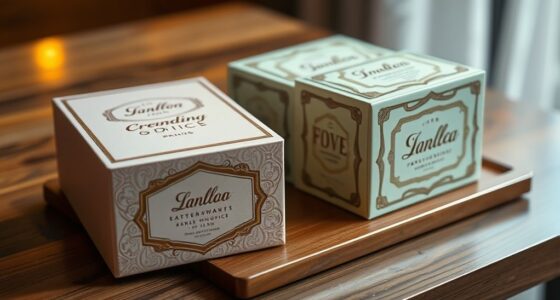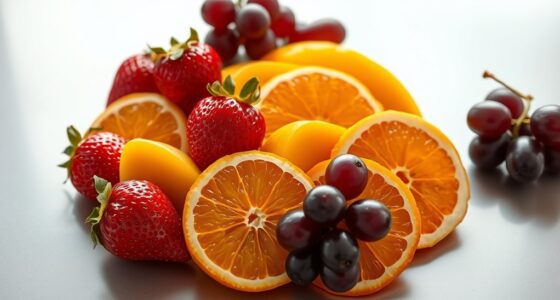Twisted sustainability combines bold, vibrant colors with eco-friendly packaging that stands out on shelves. You can support the environment by choosing designs made from biodegradable materials that naturally break down and reduce waste. Creative shapes and eye-catching patterns help communicate a brand’s commitment to sustainability while attracting consumers. Smart, standardized sizing minimizes excess and makes recycling easier. If you keep exploring, you’ll discover how innovative designs can make eco-conscious choices both stylish and impactful.
Key Takeaways
- Incorporate vibrant colors and eye-catching patterns to make sustainable packaging visually striking and appealing to consumers.
- Use innovative, creative shapes that communicate eco-friendly values while enhancing aesthetic appeal.
- Combine bold design elements with biodegradable materials to ensure both visual impact and environmental responsibility.
- Standardize packaging sizes with bright, attractive visuals to streamline manufacturing and attract eco-conscious shoppers.
- Focus on smart, minimal material use with clear disposal instructions to maximize sustainability and lifecycle efficiency.

Have you ever wondered how packaging impacts the environment? Every time you pick up a product, the packaging around it plays a bigger role than you might realize. Moving towards sustainable packaging isn’t just a trend; it’s a necessity. One of the most exciting developments in this area is the use of biodegradable materials. These materials break down naturally, reducing waste and pollution in landfills and oceans. When you choose products wrapped in biodegradable packaging, you’re actively supporting efforts to lessen our environmental footprint. These materials are often derived from renewable resources like cornstarch, sugarcane, or mushroom mycelium, making them a more eco-friendly alternative to traditional plastics. Their ability to decompose quickly and safely means less lingering waste and fewer toxins leaching into the environment.
But it’s not just about switching materials; innovative design also plays an essential role in sustainable packaging. Designers are now creating packages that are not only eco-friendly but also visually appealing and functional. Bright colors and eye-catching patterns grab your attention, making sustainable choices more attractive and accessible. This innovative design approach encourages you to see eco-friendly packaging as a stylish and modern option, rather than something dull or plain. By integrating vibrant colors and creative shapes, brands can communicate their commitment to sustainability while standing out on shelves. This visual appeal can influence your purchasing decisions, nudging you toward greener choices without sacrificing aesthetics. Additionally, incorporating standardized sizes into packaging can help streamline manufacturing and reduce excess material usage.
Moreover, innovative design isn’t just about looks—it’s about efficiency and reducing waste. Packaging that fits perfectly around products minimizes excess material, which means less waste overall. Smart design also considers ease of recycling or composting, guiding you on how to dispose of the packaging responsibly. Some brands incorporate clear labeling and instructions to make it simple for you to recycle or compost correctly. This thoughtful approach ensures that the packaging’s lifecycle is sustainable from start to finish.
Frequently Asked Questions
How Do Bright Colors Affect the Recyclability of Packaging?
Bright colors can sometimes complicate the recyclability of packaging because they influence color perception and may require separate processing streams. The visual impact of vibrant hues makes packaging stand out, but it can also lead to contamination if dyes aren’t compatible with recycling processes. To guarantee recyclability, choose colorants that are eco-friendly and compatible with recycling standards, so your packaging remains both eye-catching and sustainable.
Are There Any Health Concerns With Using Synthetic Dyes in Eco-Friendly Packaging?
Are synthetic dyes in eco-friendly packaging safe for your health? While many are generally recognized as safe, you should be aware of potential chemical safety issues and allergen risks. Some synthetic dyes may cause skin irritation or allergic reactions, especially for sensitive individuals. It’s crucial to verify that the dyes used meet safety standards and are free from harmful chemicals. Wouldn’t you prefer packaging that’s both vibrant and safe?
Can Sustainable Packaging Be as Cost-Effective as Traditional Options?
Yes, sustainable packaging can be as cost-effective as traditional options. You’ll find that a thorough cost comparison shows savings through optimized supply chain management and eco-friendly materials. While initial investments might be higher, long-term benefits like reduced waste disposal costs and consumer appeal can offset expenses. By streamlining your supply chain and choosing innovative, sustainable solutions, you can achieve competitive pricing without sacrificing quality or environmental responsibility.
How Do Consumers Perceive Brightly Colored Sustainable Packaging?
You’ll find that consumers perceive brightly colored sustainable packaging as eye-catching and innovative, thanks to color psychology. It helps evoke positive emotions and grab attention on shelves. This vibrant packaging also boosts brand recognition, making your product stand out against competitors. By using bold colors thoughtfully, you communicate your commitment to sustainability while appealing to shoppers’ visual preferences, ultimately increasing interest and loyalty toward your brand.
What Innovative Materials Are Used to Achieve Vibrant Colors Sustainably?
You can use natural pigments and biodegradable dyes to achieve vibrant colors sustainably. Natural pigments, derived from plants, minerals, or other organic sources, provide rich, eye-catching hues without harmful chemicals. Biodegradable dyes also offer bright, long-lasting colors while breaking down safely in the environment. By incorporating these innovative materials, you create bold, eco-friendly packaging that appeals to conscious consumers and reduces environmental impact.
Conclusion
You now hold the power to revolutionize packaging with bold colors and eco-friendly choices. By embracing vibrant, sustainable designs, you’re not just making a statement—you’re transforming the entire industry. This approach can turn heads faster than a lightning strike and inspire others to follow your lead. Remember, your commitment to bright, sustainable packaging isn’t just a trend; it’s a movement that could redefine what’s possible in eco-conscious branding. The future is in your hands—make it colorful and sustainable.









